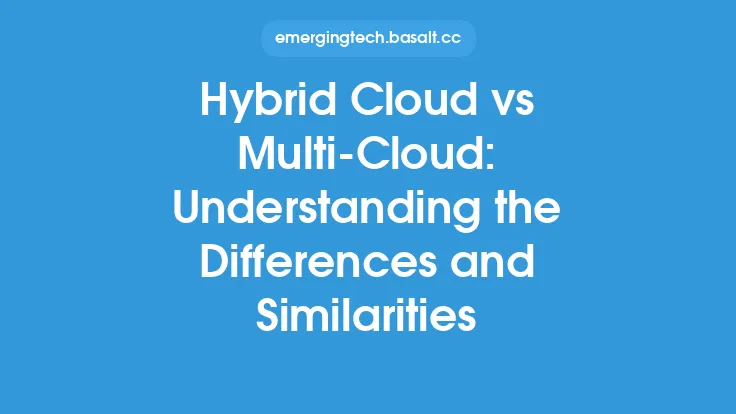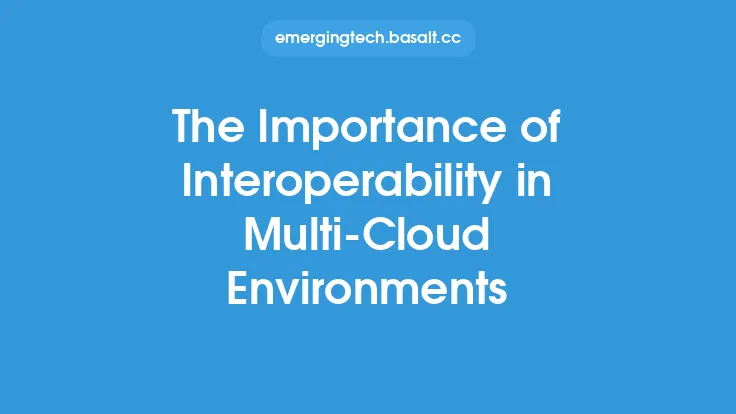In today's digital landscape, cloud computing has become an essential component of modern IT infrastructure. As organizations continue to migrate their applications and data to the cloud, they are faced with a multitude of options from various cloud service providers. This has given rise to the concept of multi-cloud, which refers to the use of multiple cloud services from different providers to meet the diverse needs of an organization. In this article, we will delve into the concept of multi-cloud, its advantages, and the key considerations for implementing a multi-cloud strategy.
Introduction to Multi-Cloud
The term multi-cloud refers to the use of two or more cloud services from different providers, such as Amazon Web Services (AWS), Microsoft Azure, Google Cloud Platform (GCP), and IBM Cloud. This approach allows organizations to leverage the strengths of each cloud provider, avoiding vendor lock-in and maximizing flexibility. Multi-cloud environments can be composed of a combination of public, private, and hybrid clouds, each with its own set of characteristics and benefits.
Key Characteristics of Multi-Cloud
A multi-cloud environment is characterized by the use of multiple cloud services, each with its own management interface, security controls, and pricing model. This can create complexity, but it also offers several advantages, including increased flexibility, improved scalability, and enhanced reliability. Some of the key characteristics of multi-cloud include:
- Heterogeneous infrastructure: Multi-cloud environments consist of different cloud services, each with its own infrastructure, such as compute resources, storage, and networking.
- Diverse management interfaces: Each cloud provider has its own management interface, which can create complexity and require specialized skills.
- Security and compliance: Multi-cloud environments require a comprehensive security and compliance strategy to ensure that data is protected and regulatory requirements are met.
Advantages of Multi-Cloud
The advantages of multi-cloud are numerous and well-documented. Some of the most significant benefits include:
- Avoiding vendor lock-in: By using multiple cloud services, organizations can avoid becoming too dependent on a single provider, reducing the risk of vendor lock-in and increasing flexibility.
- Improved scalability: Multi-cloud environments can scale more easily, as organizations can leverage the resources of multiple cloud providers to meet changing demands.
- Enhanced reliability: By using multiple cloud services, organizations can improve reliability, as the failure of one cloud service will not bring down the entire infrastructure.
- Increased flexibility: Multi-cloud environments offer increased flexibility, as organizations can choose the best cloud service for each application or workload.
Technical Considerations for Multi-Cloud
Implementing a multi-cloud strategy requires careful consideration of several technical factors, including:
- Cloud interoperability: Ensuring that different cloud services can communicate and exchange data seamlessly is critical for a successful multi-cloud strategy.
- Security and compliance: Implementing a comprehensive security and compliance strategy is essential for protecting data and meeting regulatory requirements in a multi-cloud environment.
- Networking and connectivity: Ensuring that networking and connectivity between different cloud services are secure and reliable is critical for a successful multi-cloud strategy.
- Management and monitoring: Implementing a unified management and monitoring framework is essential for managing and optimizing a multi-cloud environment.
Cloud Service Providers and Multi-Cloud
The major cloud service providers, including AWS, Azure, GCP, and IBM Cloud, offer a range of services and tools to support multi-cloud environments. These include:
- Cloud-agnostic services: Many cloud service providers offer cloud-agnostic services, such as containerization and serverless computing, which can run on multiple cloud platforms.
- Hybrid cloud solutions: Some cloud service providers offer hybrid cloud solutions, which allow organizations to run applications and workloads on-premises and in the cloud.
- Multi-cloud management tools: Many cloud service providers offer multi-cloud management tools, which provide a unified interface for managing and monitoring multiple cloud services.
Best Practices for Implementing Multi-Cloud
Implementing a successful multi-cloud strategy requires careful planning and execution. Some best practices for implementing multi-cloud include:
- Develop a clear strategy: Define a clear multi-cloud strategy that aligns with business objectives and requirements.
- Assess cloud readiness: Assess the readiness of applications and workloads for cloud migration and identify the best cloud service for each.
- Implement a unified management framework: Implement a unified management framework to manage and monitor multiple cloud services.
- Ensure security and compliance: Ensure that security and compliance requirements are met in a multi-cloud environment.
Conclusion
In conclusion, multi-cloud is a powerful approach to cloud computing that offers several advantages, including increased flexibility, improved scalability, and enhanced reliability. By understanding the concept of multi-cloud and its advantages, organizations can make informed decisions about their cloud strategy and implement a successful multi-cloud environment. While implementing a multi-cloud strategy requires careful consideration of several technical factors, the benefits of multi-cloud make it an attractive option for organizations looking to maximize the benefits of cloud computing.





